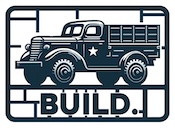A few years back, I ordered the Alliance Modelworks FAMO mit Flak 88 conversion kit. It’s been sitting on my workbench since then, calling my name so sweetly. Well, I finally listened and busted it out.
This conversion kit takes the Tamiya FAMO (#35329) and the Dragon’s 8.8cm Flak37 (#6287) and reworks with resin and photoetch. At $150 USD, it’s a pricey kit for a big vehicle.
I have mixed feelings about this kit. At first glance, the instructions are clear, the resin parts have crisp details, and the photoetch was nicely done. And the subject was an interesting one, so I was excited looking at the parts and instructions to get started.
Like so many conversion kits, however, it’s the details that matter. While the instructions are some of the best for conversion kits I’ve seen, they are still lacking in a number of ways, in a number of places. Even a few notes along the way from someone who’d built the kit would have made these world class instructions. Locating the support rails for the real platform (front to back, as well as right to left) was confusing. A few lines of text from someone who’d built the kit would have made this incredibly easy. As it was, I had to build and test-fit to figure out the right position. I also had to google for images constantly to figure out how pieces went together. And I’m pretty certain I’ve completely missed the mark on the real platform. If Alliance Modelworks had done a few simple things, we builders would have had a much happier experience:
- Add explanation text to accompany the images
- Add more images… A couple extra pages of build detail wouldn’t have been a major effort for the creators
- Provide HIGH QUALITY LARGE images of the official build model on the web site so we builders can see clearly where pieces go. Why oh why would the company only put up smaller version of their fantastic photos??
- Add a tips and tricks collection as feedback comes in from builders to the product page on their site
In real life, this was a low production, war’s end vehicle with very little surviving documentation. We need all the help we can get. Unlike a Tiger I, I can’t go to the library and find 43 books on every detail, or pop by a museum to see one in person.
On to the parts… First the good: the photoetch. Multiple frets of various thicknesses are designed perfectly for each part. The thick front armor plate, for instance, is quite thick. As it should be. Smaller details were on thinner frets. I only had one instance of the thin parts breaking during folding.
Now on to the bad…. The resin. While the surface details were pretty impressive in most cases, it’s generally been a nightmare. I had to email Alliance twice to get replacements for the cab floor part, as the first was insanely warped, the second was broken and warped, and the third was just slightly less warped. I gave up and tried to heat and bend into shape. My resin bending skills are marginal, so I just opted to close the doors.
Except as I write this review, I’m struggling through making the doors fit properly. I’m seriously considering tossing them and building replacements that I know I can get to fit easier. You have to cut out the braces from the single piece cab, but knowing where the lines between part and brace are extremely hard to find. Fine edges for the overhangs above the doors are so thin, one side was broken on arrival and the other was snapped off with a minor, minor errant knife slice. And the way the roof hatches are casts, I ended up shaving off the necessary lips on accident. And of course, warpage was a huge problem on more than just the cab floor.
I am going to replace the fold down benches because there is so much flash between the bench slats, it’s nearly impossible to clean up without damaging the slats.
I’m also working on replacing the stabilizers because of poor detail and warpage of the resin parts.
With conversion kits, I feel like there’s a three legged stool of:
- Quality – how is the material itself? Is there flash? Are the instructions clear? Where are the knock outs/fret connections/casting plugs?
- Cost – is the price point reasonable for what you’re getting?
- Love – yes, I said it… Is there an attention to detail that shows you that the manufacturer put the time in to make something great? Did they do their research to get it right, or include details/accessories that make the kit sing?
These three need to work together to make a great kit. Quality could be marginal, and cost could be standard, but that extra bit of love makes a great kit overall. Or if cost is too grand, the love and quality might not be able to make up for it.
With this kit, cost is prohibitive against the other two categories. It’s a great kit, overall and certainly in context of how many truly awful conversion kits are out there. But at $150, the resin should have been top notch, or the experience overall should have been much tighter with better instructions, and web based images and tips to help put it together. Be ready to do some work on the resin, but it shapes up in a pretty impressive build.












Woow it’s a great conversion kit and certainly requires hard work